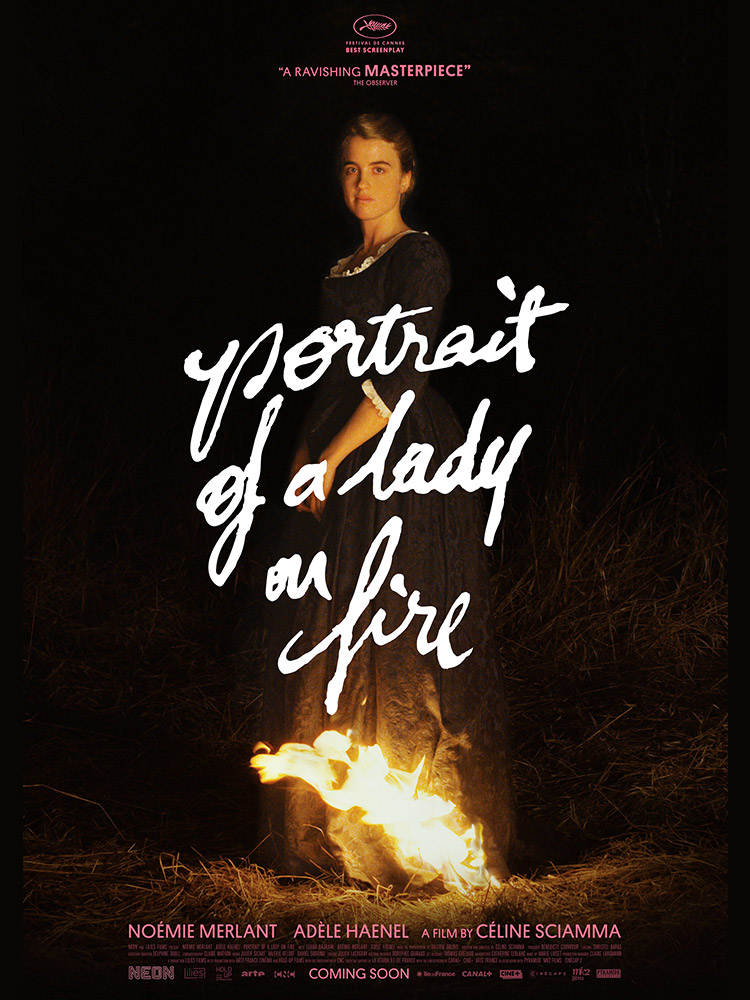03 Mar Portrait of a Lady on Fire (France)
Released 2019
SUNDAY 15 MAY 2022 – 10.00 am
TUESDAY 17 MAY 2022 – 8.15 pm
DIRECTOR : Celine Sciamma
RUNNING TIME 122 minutes
SYNOPSIS
This French historical drama written and directed by Celine Sciamma is set in the late 18th C. It tells the story of a forbidden affair between an aristocrat and a painter commissioned to paint her portrait.
REVIEW: Mark Kermode
What a thrillingly versatile film-maker Céline Sciamma has proved to be. Her impressive screenplay credits include Claude Barras’s My Life as a Courgette, a tenderly empathetic, French-Swiss stop-motion masterpiece that earned an Oscar nomination for its vividly resilient depiction of children in care. In each of her very different projects, Sciamma has struck an accessible chord by focusing tightly on specifics, finding the key to universal appeal in the unique, tiny details of each story and character.
For her fourth feature as writer-director, Sciamma ventures to a new world of the late 18th century. We first meet Marianne (Noémie Merlant) teaching life study in Paris to art students, one of whom stumbles upon her titular painting. An arresting night-time image of a woman whose dress is hemmed with flames, this painting provides a portal to the past. Through it, we are transported back to Marianne’s stormy, sea-bound arrival at a remote Brittany residence where she is to paint former convent girl Héloïse (Adéle Haenel). Héloïse’s countess mother (played with imperious fragility by Valeria Golino) intends to send the painting to a Milanese nobleman; if he approves, her daughter will be wed and they will both be transported to a new life. But Héloïse has no desire to be married, and has already defeated one painter who left without ever seeing her face. So Marianne, who has been brought here on the pretext of being a chaperone and companion, must study and paint her subject in secret, looking without appearing to look…
That this deception should soon be revealed is no surprise – the electric tension between the pair prevents either of them from keeping secrets for long. Yet when confronted with Marianne’s first attempt to capture her likeness, Héloïse is appalled. “Is that how you see me?” she demands, stunned less by Marianne’s deceit than by the lack of life – of “presence” – in her picture. “The fact it isn’t close to me, that I can understand,” she says bitterly. “But I find it sad it isn’t close to you.”
What follows is an intellectually erotic study of power and passion in which observed becomes observer, authored becomes author, returning time and again to a central question: “If you look at me, who do I look at?” It’s a question that reverberates throughout Sciamma’s playfully literate film, which rightly won the Cannes prize for best screenplay in 2019. We hear it echoed in a historically accurate discussion of the way the art world keeps women in their place by proscribing the subjects of their gaze, their inquiry. More significantly, it informs an ongoing debate about the myth of Orpheus and Eurydice that runs like a silver thread through the drama. “He doesn’t make the lover’s choice, but the poet’s,” Marianne says of Orpheus and his fateful decision to look back as he ascends from the underworld. But perhaps that decision was not his to make? Could Eurydice be the author of her own fate, the commander of his gaze?
Digitally filmed in tactile, painterly hues by Claire Mathon, Portrait of a Lady on Fire (the French title uses the less Jamesian “jeune fille”) seamlessly intertwines themes of love and politics, representation and reality. At times it plays like a breathless romance, trembling with passionate anticipation. Elsewhere, it seems closer to a socio-political treatise, what Sciamma has called “a manifesto about the female gaze”. Ghostly images of Héloïse in her wedding dress lend a quasi-gothic edge, and there’s something of the Brontës in the cliffside walks she embraces with abandon. Yet Sciamma is careful to keep such heightened emotions rooted in the firm soil of social realism.
A subplot about young maid Sophie (Luàna Bajrami) dealing with an unwanted pregnancy finds Sciamma at her most quietly radical, not only confronting but also depicting a taboo subject and its representation, refusing to look away, finding strength in sorority.
Musically, Sciamma keeps things sparse and diegetic, mirroring Héloïse’s cloistered experience (she longs to hear an orchestra), emphasising her silenced sense of imprisonment. All the more significant, then, that a signature scene bursts into vibrant song – a chorus of live vocals and handclaps that momentarily lifts the film into an ecstatically uncanny reverie, as mesmerisingly magical as anything I can recall seeing on screen.
Source: www.theguardian.com Mark Kermode 1/3/2020 / Last modified on 12/12/20. Edited extracts ~ accessed 8/5/21



